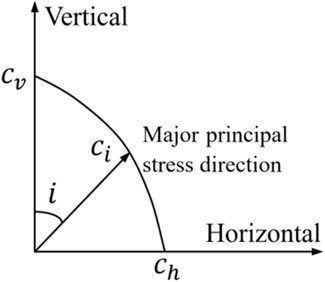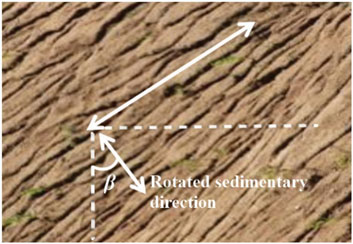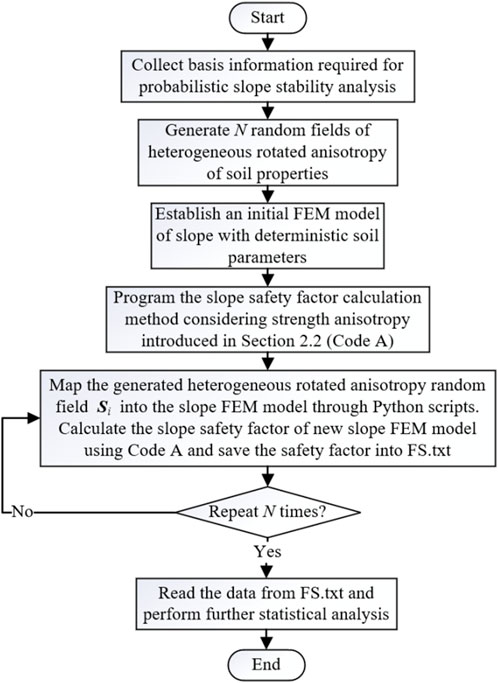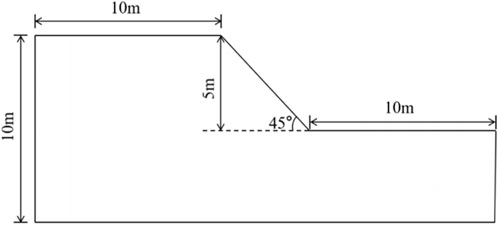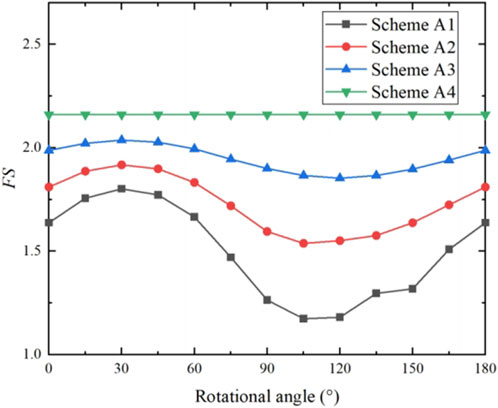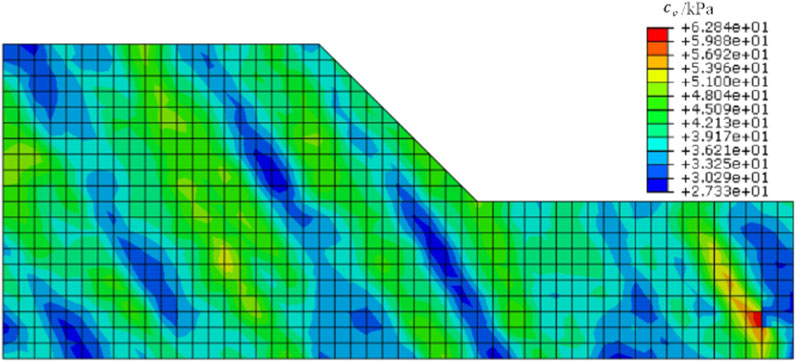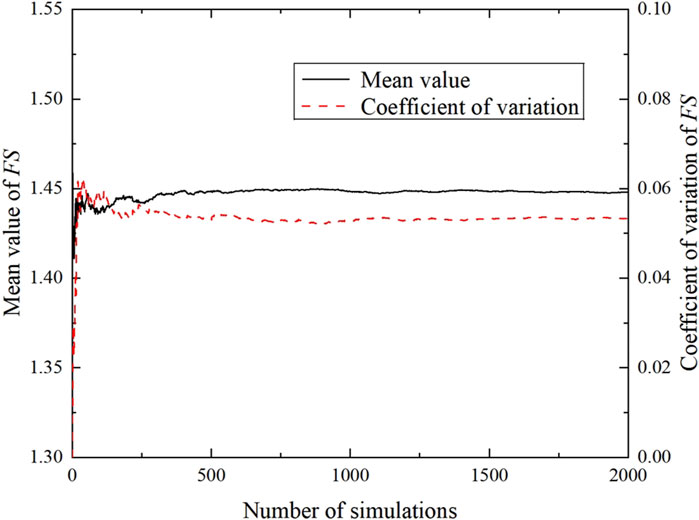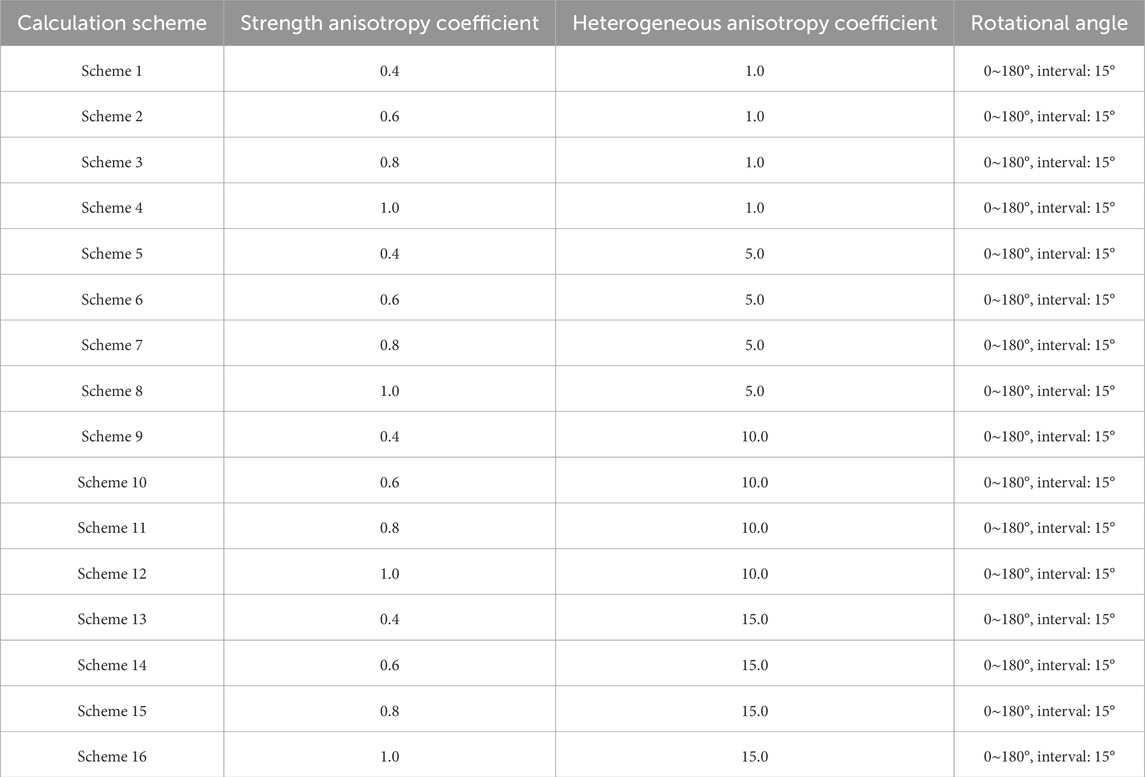- 1School of Architectural Engineering, North China Institute of Science and Technology, Langfang, China
- 2School of Transportation Science and Engineering, Beihang University, Beijing, China
- 3School of Architecture, Yanching Institute of Technology, Langfang, China
Strength anisotropy and heterogeneous rotated anisotropy are prevalent phenomena in natural slopes. Previous studies have underscored their significance in slope stability analysis. However, in previous slope stability analyses, the effects of strength anisotropy and heterogeneous rotated anisotropy on slope stability were studied separately, without considering their coupled effect. This paper aims to propose a probabilistic analysis framework of slope stability considering the coupled effect of strength anisotropy and heterogeneous rotated anisotropy. Through an undrained clay slope case, the proposed probabilistic analysis framework is examined. The influence of strength anisotropy and heterogeneous rotated anisotropy on slope stability is investigated. The results show that the proposed probabilistic analysis framework of slope stability considering the coupled effect of strength anisotropy and heterogeneous rotated anisotropy is effective. Both strength anisotropy and heterogeneous rotated anisotropy have an important influence on slope stability. Furthermore, the statistics of safety factor including mean value, coefficient of variation, and reliability index, vary with the strength anisotropy coefficient, the heterogeneous anisotropy coefficient, and the rotational angle. The smaller the strength anisotropy coefficient, the larger the heterogeneous anisotropy coefficient, and the smaller the reliability index. The rotational angle of strata corresponding to the minimum and maximum values of the slope reliability index is sensitive to the strength anisotropy coefficient, but not to the heterogeneous anisotropy coefficient.
1 Introduction
The soil layers in nature are very complex due to the influence of material composition, depositional conditions, stress history, and geological effects (Phoon and Kulhawy, 1999; Al-Karni and Al-Shamrani, 2000; Elkateb et al., 2003; Nian et al., 2008). Soil particles will be arranged in a certain direction during sedimentation, which makes the shear strength of the soil in the vertical direction (initial sedimentary direction) greater than that in the horizontal direction (Wang and Jin, 2008; Tang et al., 2020). It is called the strength anisotropy and the soil properties will change with the stress state (Yu and Sloan, 1994; Hwang et al., 2002; Bozorgpour et al., 2021). Under the action of geostress, soil layers will rotate at a certain angle. Therefore, the initial sedimentary direction will also rotate, and the direction of maximum shear strength will not be vertical. On the other hand, the properties of natural soil layers are heterogeneous in space and there is a difference in soil parameters at different spatial points. It is called the spatial variability of soil parameters (Griffiths and Fenton, 2001; Elkateb et al., 2003; Dasaka and Zhang, 2012; Jiang et al., 2014; Li et al., 2016; Deng et al., 2017; Deng et al., 2022). Due to the influence of sedimentation, the variation characteristics in the vertical direction are stronger than that in the horizontal direction (heterogeneous anisotropy). Under the action of geostress, soil layers usually undergo rotation, and the direction with the strongest variation of soil parameters also undergoes rotation. It is more common in natural soil layers and is called soil parameters rotated anisotropy or heterogeneous rotated anisotropy (Zhu and Zhang, 2013). Strength anisotropy and heterogeneous rotated anisotropy are different and coexist in nature. Strength anisotropy refers to the variation of soil mechanical properties with the direction of principal stress, while heterogeneous rotated anisotropy refers to the spatial differences in soil mechanical properties (Bozorgpour et al., 2021).
Slope stability issues not only affect foundation pits and highway projects but also play a crucial role in tunnel excavation (Tian et al., 2024a; 2024b). Particularly in complex geological conditions, such as weak surrounding rock, steep slopes, or areas with abundant groundwater, slope instability poses a serious threat to construction safety and structural stability. Commonly used methods for slope stability analysis include graphical method, limit equilibrium method (Azarafza et al., 2021), and numerical analysis method. In recent years, machine learning methods have also been applied to analyze slope stability (Nanehkaran et al., 2022; 2023). However, most slope stability analyses are generally based on the assumption that the soil is isotropic and homogeneous (Ma and Yao, 2024). Due to the existence of strength anisotropy and heterogeneity in reality, traditional slope stability assessment methods may overestimate the safety factor of slopes. Several studies on slope stability have considered the strength anisotropy. Chen et al. (1975) studied the slope stability considering the shear strength anisotropy and the linear variation of cohesion with depth. They established an expression for the safety factor of slope with soil parameters of
Nowadays, more and more attention has been paid to the stability analysis of slopes considering the rotated anisotropy of soil properties (Huang et al., 2019; Zhu et al., 2019; Ding et al., 2021; Huang et al., 2021; Wang et al., 2021; Chen et al., 2022). Cheng et al. (2017) used the covariance matrix decomposition method to simulate the rotated anisotropy random field of undrained shear strength, and studied the influence of the rotated anisotropy correlation structure on slope stability. Li et al. (2022) proposed an integrated probabilistic analysis framework to investigate the effect of soil parameters rotated anisotropy on the stability of pile-reinforced slopes. The optimal reinforcement scheme of stabilizing piles is analyzed based on the proposed probabilistic analysis framework. Ma et al. (2022) evaluated the most critical fabric orientation for the post-failure behavior and explored the impact of soil parameters rotated anisotropy on runout movements of landslides. The results revealed that the spatial variability of
However, previous studies on the stability of slopes still have some limitations. The effects of strength anisotropy and heterogeneous rotated anisotropy were considered separately (Bozorgpour et al., 2021). Few studies considered the coupled effect of strength anisotropy and heterogeneous rotated anisotropy on slope stability. This paper aims to propose a probabilistic analysis framework of slope stability considering the coupled effect of strength anisotropy and heterogeneous rotated anisotropy. An algorithm for calculating the safety factor of slopes considering strength anisotropy and heterogeneous rotated anisotropy is developed. Then, through an undrained clay slope case, the influence of strength anisotropy and heterogeneous rotated anisotropy on the slope stability is investigated.
2 Methodology
2.1 Characterization of strength anisotropy
Most soils in their natural states exhibit some anisotropy with respect to shear strength. The long-term sedimentation process leads to the directional arrangement of soil particles, and the strength of the soil in the initial sedimentary direction (usually vertical) is higher than that in other directions (Yu and Sloan, 1994). Generally speaking, the larger the angle between the direction of major principal stress and the initial sedimentary direction, the lower the strength of the soil. There are large differences in the stress state of the soil at different positions of a slope, and the orientation of major principal stress rotates to varying degrees (Li et al., 2023). The major and minor principal stress directions of the soil elements on the sliding surface of slope are shown in Figure 1. The major principal stress near the middle and bottom of the sliding surface deviates significantly from the vertical direction, and the deflection angle may even be close to 90° (Wang and Jin, 2008). The strength anisotropy of soil results in lower strength in these areas than that at the top of slope. If the stability of slope is evaluated uniformly according to the strength in the initial sedimentary direction, a higher safety factor will be obtained, which may lead to the failure of slope in reality.
If the slope is analyzed under undrained conditions, the undrained shear strength is used to characterize the mechanical behavior of soil. The undrained shear strength is strongly dependent on the angle between the direction of major principal stress and the direction of soil deposition. Previous studies have mostly determined the anisotropic undrained shear strength using Equation 1 (Chen et al., 1975; Al-Karni and Al-Shamrani, 2000):
where
To indicate the degree of strength anisotropy, a strength anisotropy coefficient is defined by Equation 2:
The range of the strength anisotropy coefficient is 0∼1.0. The smaller the strength anisotropy coefficient, the stronger the degree of strength anisotropy; Otherwise, the opposite. When the strength anisotropy coefficient is 1.0, the soil is an isotropic material and the undrained shear strength is independent of the direction of principal stress.
After sedimentation, the soil layers undergo rotation under the action of geostress, and the sedimentary direction will rotate (see Figure 3). The angle between the rotated sedimentary direction and the vertical direction (initial sedimentary direction) is called the rotational angle
2.2 Slope stability analysis considering strength anisotropy based on ABAQUS
The Mohr Coulomb ideal elastic-plastic model is used to describe the stress-strain relationship of soil and ABAQUS software is used to analyze the slope stability in this paper. There is no Mohr Coulomb model with strength anisotropy in ABAQUS. Therefore, the user-defined material (UMAT) development of Mohr Coulomb model with strength anisotropy must be conducted. This paper adopts an explicit integration algorithm with automatic substepping and error control when developing the UMAT subroutine (Sloan, 1987; Sloan et al., 2001; Zhang and Zhou, 2016; Zhang et al., 2019). It should be noted that in each incremental step, we need to determine the direction of the major principal stress based on the stress state of the element integration point, and then update the undrained shear strength of the soil according to Equation 1. Note that if the soil layers undergo rotation, the angle
The finite element strength reduction method is a commonly used calculation method of slope safety factor. The basic idea is to reduce the undrained shear strength of the soil until the reduction factor
(1) Give the initial range of the reduction coefficient (for example, 0.1∼10.0). Mark the upper and lower limits of the reduction coefficient as
(2) Take the midpoint value (denoted as
(3) Determine the value of undrained shear strength in the rotated sedimentary direction
(4) Determine whether the slope stability calculation converges. If the calculation converges, the lower limit of the reduction coefficient is set to be
(5) Repeat Steps 2∼4, until the difference between the upper and lower limits of the reduction coefficient is less than the specified error (for example, 0.001). At this time, the midpoint value of the upper and lower limits of the reduction coefficient is taken as the
2.3 Simulation of heterogeneous rotated anisotropy
The heterogeneous rotated anisotropy widely exists in nature (shown in Figure 4), and can be simulated using the random field theory. In the heterogeneous rotated anisotropic soil layers, the scales of fluctuation (SOFs) of undrained shear strength in the strongest and weakest directions of correlation are denoted as
The larger the heterogeneous anisotropy coefficient, the higher the degree of anisotropy in the soil parameter random field; Otherwise, the opposite. When
In random field theory, autocorrelation functions are often used to describe the autocorrelation between soil parameters at two different spatial positions. There are various types of autocorrelation functions, such as triangular, exponential, Gaussian, and so on. Among them, exponential and Gaussian autocorrelation functions are often used in geotechnical engineering and the exponential autocorrelation function is used in this paper. The formula of exponential autocorrelation function is as follows, see Equation 4:
where
After determining the autocorrelation function, the domain Ω is divided into
where
Suppose
If the soil parameter
where
2.4 Probabilistic analysis framework of slope stability considering strength anisotropy and heterogeneous rotated anisotropy
To consider strength anisotropy and heterogeneous rotated anisotropy in slope stability analysis, a probabilistic analysis framework is proposed. The probabilistic analysis framework is based on ABAQUS and Python. The flow chart in Figure 5 shows the main steps of the program development of the probabilistic analysis framework. The main steps are as follows:
(1) Collect basis information required for probabilistic slope stability analysis. The information includes the geometric dimensions of slope, the statistical data of heterogeneous rotated anisotropy of soil parameters (distribution type, mean value, coefficient of variation, scales of fluctuation, rotational angle, etc.), and strength anisotropy parameters of soil.
(2) Generate
(3) Establish an initial finite element method (FEM) model of slope with deterministic soil parameters.
(4) The slope safety factor calculation method considering strength anisotropy introduced in Section 2.2 is programmed based on ABAQUS and Python. The developed program is denoted as Code A.
(5) Based on the initial FEM model of the slope, map the generated heterogeneous rotated anisotropy random field
(6) Use Python scripts to repeat Step 5, until
(7) Read the data from FS.txt and perform further statistical analysis.
3 Case study
Taking a cohesive soil slope as an example, the influence of strength anisotropy and heterogeneous rotated anisotropy on slope stability is investigated in this section. As shown in Figure 6, the height of the slope is 5m, and the slope angle is 45°. Assuming undrained conditions, the undrained shear strength in the rotated sedimentary direction
3.1 Deterministic analysis
The deterministic analysis is conducted first using the developed finite element algorithm introduced in Section 2.4. All soil parameters are considered as determined values. Take 40 kPa as the value of
3.2 Stochastic analysis
3.2.1 Simulation of rotational anisotropy random field of soil parameters
To consider the impact of rotational anisotropy of soil parameters on slope stability, the rotational anisotropy random field of soil parameters should be generated first. The steps for generating rotational anisotropy random field of soil parameters are introduced in Section 2.3. Figure 8 shows the random field of undrained shear strength
3.2.2 Determination of the number of simulations
To obtain accurate statistics of
3.2.3 Influence of strength anisotropy and heterogeneous rotated anisotropy on slope stability
To study the influence of strength anisotropy and heterogeneous rotated anisotropy on slope reliability, 16 calculation schemes (shown in Table 1) with different strength coefficients, heterogeneous anisotropy coefficients, and rotational angles, are adopted to conduct the slope stability analysis.
Assuming
where
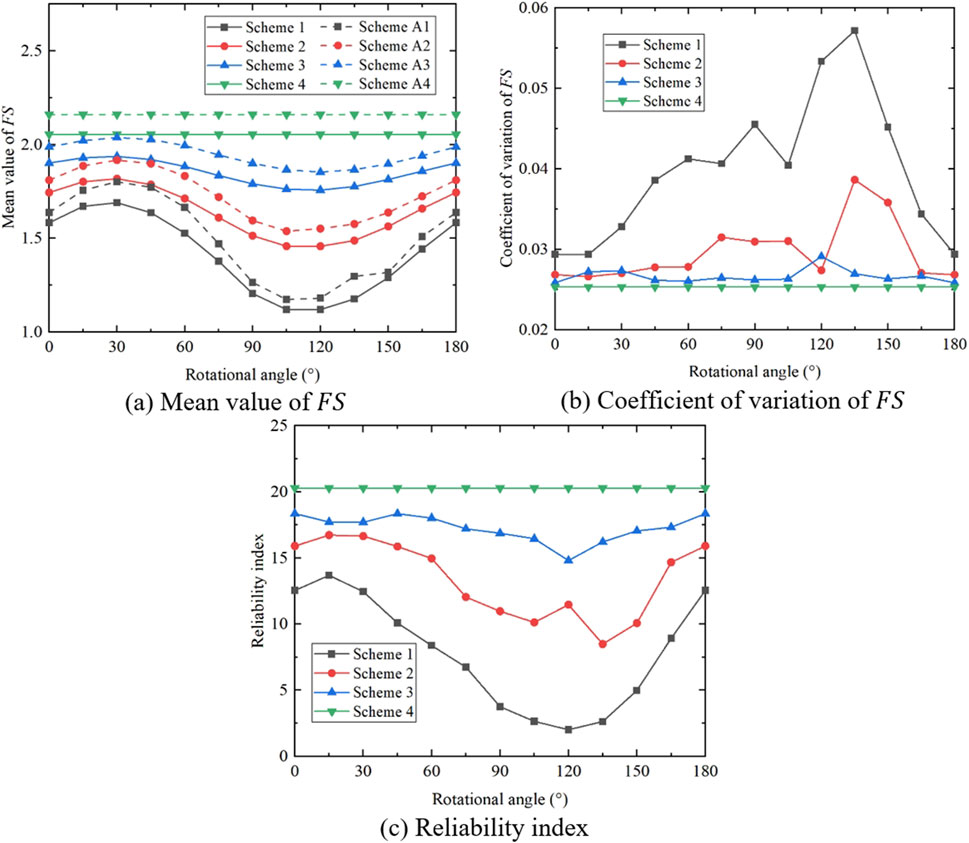
Figure 10. Variation of statistics of

Figure 11. Variation of statistics of
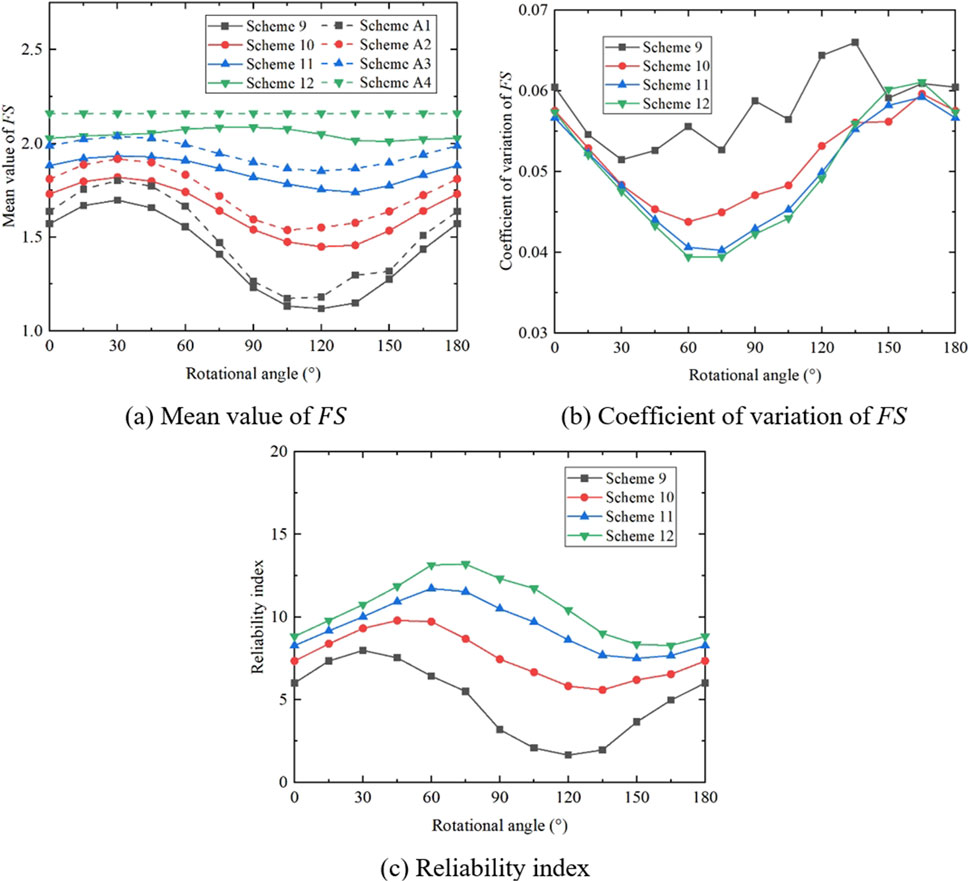
Figure 12. Variation of statistics of

Figure 13. Variation of statistics of
The coefficient of variation of
As for the reliability index, the change law of the reliability index with the rotational angle is similar to that of the mean value of
To better study the influence of the heterogeneous anisotropy coefficient on slope stability, the calculation results of the 16 schemes are drawn with the same strength anisotropy coefficient and different heterogeneous anisotropy coefficients (see Figures 14–17). It can be seen that under the same strength anisotropy coefficient, with the increase of the heterogeneous anisotropy coefficient, there is little difference in the curves of the mean value of

Figure 14. Variation of statistics of
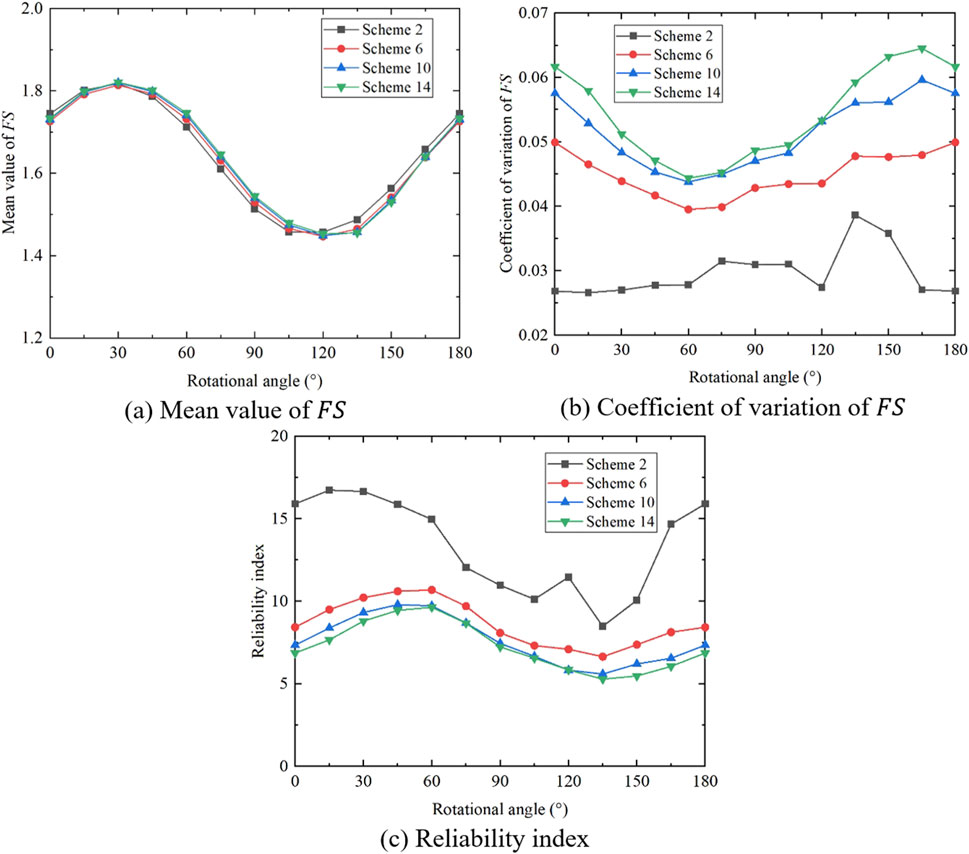
Figure 15. Variation of statistics of
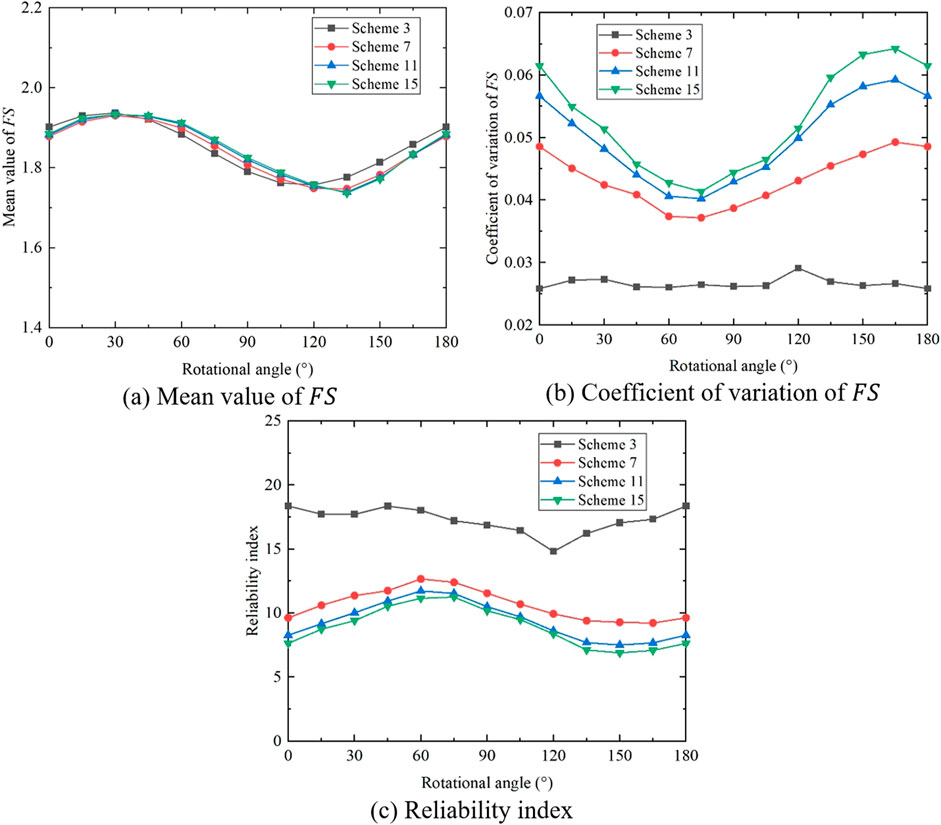
Figure 16. Variation of statistics of

Figure 17. Variation of statistics of
4 Conclusion
In this paper, a probabilistic analysis framework of slope stability considering the coupled effect of strength anisotropy and heterogeneous rotated anisotropy is proposed. The slope stability under different degrees of strength anisotropy and heterogeneous rotated anisotropy is analyzed. The main conclusions can be drawn as follows:
(1) The proposed probabilistic analysis framework of slope stability considering the coupled effect of strength anisotropy and heterogeneous rotated anisotropy is effective.
(2) Under the same rotational angle, the
(3) The strength anisotropy coefficient, the heterogeneous anisotropy coefficient, and the rotational angle have important effects on slope stability. The mean value of
(4) The rotational angles corresponding to the minimum and maximum values of the reliability index are greatly influenced by the strength anisotropy coefficient but are less affected by the heterogeneous anisotropy coefficient. With the increase of the strength anisotropy coefficient, the safest rotational angles can increase from 30
Data availability statement
The original contributions presented in the study are included in the article/supplementary material, further inquiries can be directed to the corresponding author.
Author contributions
WC: Conceptualization, Methodology, Software, Validation, Writing – original draft, Writing – review and editing. WL: Methodology, Validation, Visualization, Writing – review and editing. HY: Data curation, Software, Writing – review and editing. YL: Funding acquisition, Software, Visualization, Writing – review and editing.
Funding
The author(s) declare that financial support was received for the research and/or publication of this article. This research was funded by the National Natural Science Foundation of China (Project Nos 42177170 and 52004090), the Natural Science Foundation of Hebei Province (Project Nos E2021508031 and E2024508032) and the Fundamental Research Funds for the Central Universities (3142021010). The financial support is greatly acknowledged.
Conflict of interest
The authors declare that the research was conducted in the absence of any commercial or financial relationships that could be construed as a potential conflict of interest.
Generative AI statement
The author(s) declare that no Gen AI was used in the creation of this manuscript.
Publisher’s note
All claims expressed in this article are solely those of the authors and do not necessarily represent those of their affiliated organizations, or those of the publisher, the editors and the reviewers. Any product that may be evaluated in this article, or claim that may be made by its manufacturer, is not guaranteed or endorsed by the publisher.
References
Al-Karni, A. A., and Al-Shamrani, M. A. (2000). Study of the effect of soil anisotropy on slope stability using method of slices. Comput. Geotech. 26 (2), 83–103. doi:10.1016/S0266-352X(99)00046-4
Azarafza, M., Akgün, H., Ghazifard, A., Asghari-Kaljahi, E., Rahnamarad, J., and Derakhshani, R. (2021). Discontinuous rock slope stability analysis by limit equilibrium approaches–a review. Int. J. Digit. Earth. 14 (12), 1918–1941. doi:10.1080/17538947.2021.1988163
Bozorgpour, M. H., Binesh, S. M., and Rahmani, R. (2021). Probabilistic stability analysis of geo-structures in anisotropic clayey soils with spatial variability. Comput. Geotech. 133, 104044. doi:10.1016/j.compgeo.2021.104044
Chen, L., Zhang, W., Chen, F., Gu, D., Wang, L., and Wang, Z. (2022). Probabilistic assessment of slope failure considering anisotropic spatial variability of soil properties. Geosci. Front. 13 (3), 101371. doi:10.1016/j.gsf.2022.101371
Chen, W. F., Snitbhan, N., and Fang, H. Y. (1975). Stability of slopes in anisotropic, nonhomogeneous soils. Can. Geotech. J. 12 (1), 146–152. doi:10.1139/t75-014
Cheng, H. Z., Chen, J., Wang, Z. S., Hu, Z. F., and Huang, J. H. (2017). Stability analysis of a clay slope accounting for the rotated anisotropy correlation structure. Chin. J. Rock Mech. Eng. 36 (S2), 3965–3973. doi:10.13722/j.cnki.jrme.2017.0044
Dasaka, S. M., and Zhang, L. M. (2012). Spatial variability of in situ weathered soil. Geotechnique 62 (5), 375–384. doi:10.1680/geot.8.P.151.3786
Deng, Z. P., Li, D. Q., Qi, X. H., Cao, Z. J., and Phoon, K. K. (2017). Reliability evaluation of slope considering geological uncertainty and inherent variability of soil parameters. Comput. Geotech. 92, 121–131. doi:10.1016/j.compgeo.2017.07.020
Deng, Z. P., Pan, M., Niu, J. T., and Jiang, S. H. (2022). Full probability design of soil slopes considering both stratigraphic uncertainty and spatial variability of soil properties. Bull. Eng. Geol. Environ. 81 (5), 195. doi:10.1007/s10064-022-02702-2
Ding, Y. N., Li, D. Q., Zarei, C., Yi, B. L., and Liu, Y. (2021). Probabilistically quantifying the effect of geotechnical anisotropy on landslide susceptibility. Bull. Eng. Geol. Environ. 80, 6615–6627. doi:10.1007/s10064-021-02197-3
Elkateb, T., Chalaturnyk, R., and Robertson, P. K. (2003). An overview of soil heterogeneity: quantification and implications on geotechnical field problems. Can. Geotech. J. 40 (1), 1–15. doi:10.1139/t02-090
Griffiths, D. V., and Fenton, G. A. (2001). Bearing capacity of spatially random soil: the undrained clay Prandtl problem revisited. Geotechnique 51 (4), 351–359. doi:10.1680/geot.2001.51.4.351
Huang, L., Cheng, Y. M., Leung, Y. F., and Li, L. (2019). Influence of rotated anisotropy on slope reliability evaluation using conditional random field. Comput. Geotech. 115, 103133. doi:10.1016/j.compgeo.2019.103133
Huang, L., Cheng, Y. M., Li, L., and Yu, S. (2021). Reliability and failure mechanism of a slope with non-stationarity and rotated transverse anisotropy in undrained soil strength. Comput. Geotech. 132, 103970. doi:10.1016/j.compgeo.2020.103970
Hwang, J., Dewoolkar, M., and Ko, H. Y. (2002). Stability analysis of two-dimensional excavated slopes considering strength anisotropy. Can. Geotech. J. 39, 1026–1038. doi:10.1139/t02-057
Jiang, S. H., and Huang, J. S. (2016). Efficient slope reliability analysis at low-probability levels in spatially variable soils. Comput. Geotech. 75, 18–27. doi:10.1016/j.compgeo.2016.01.016
Jiang, S. H., Li, D. Q., Zhang, L. M., and Zhou, C. B. (2014). Slope reliability analysis considering spatially variable shear strength parameters using a non-intrusive stochastic finite element method. Eng. Geol. 168, 120–128. doi:10.1016/j.enggeo.2013.11.006
Li, J. Z., Zhang, S. H., Liu, L. L., Huang, L., Cheng, Y. M., and Dias, D. (2022). Probabilistic analysis of pile-reinforced slopes in spatially variable soils with rotated anisotropy. Comput. Geotech. 146, 104744. doi:10.1016/j.compgeo.2022.104744
Li, X. Y., Zhang, L. M., and Li, J. H. (2016). Using conditioned random field to characterize the variability of geologic profiles. J. Geotech. Geoenviron. Eng. 142, 04015096. doi:10.1061/(asce)gt.1943-5606.0001428
Li, Y., Goh, A. T. C., Zhang, R., and Zhang, W. (2023). Stability charts for undrained clay slopes considering soil anisotropic characteristics. Bull. Eng. Geol. Environ. 82 (2), 52. doi:10.1007/s10064-023-03067-w
Liu, L., Liang, C., Xu, M., Zhu, W., Zhang, S., and Ding, X. (2023). Probabilistic analysis of large slope deformation considering soil spatial variability with rotated anisotropy. J. Earth Sci. 48 (5), 1836–1852. doi:10.3799/dqkx.2022.372
Ma, G., Rezania, M., Mousavi Nezhad, M., and Hu, X. (2022). Uncertainty quantification of landslide runout motion considering soil interdependent anisotropy and fabric orientation. Landslides 19, 1231–1247. doi:10.1007/s10346-021-01795-2
Ma, N., and Yao, Z. (2024). Analysis of slope stochastic fields using a novel deep learning model with attention mechanism. Front. Earth Sci. 12, 1352958. doi:10.3389/feart.2024.1352958
Myers, D. E. (1989). Vector conditional simulation. Geostatistics 4, 283–293. doi:10.1007/978-94-015-6844-9_21
Nanehkaran, Y. A., Licai, Z., Chengyong, J., Chen, J., Anwar, S., Azarafza, M., et al. (2023). Comparative analysis for slope stability by using machine learning methods. Appl. Sci. 13 (3), 1555. doi:10.3390/app13031555
Nanehkaran, Y. A., Pusatli, T., Chengyong, J., Chen, J., Cemiloglu, A., Azarafza, M., et al. (2022). Application of machine learning techniques for the estimation of the safety factor in slope stability analysis. Water 14 (22), 3743. doi:10.3390/w14223743
Ng, C. W. W., Qu, C., Ni, J., and Guo, H. (2022). Three-dimensional reliability analysis of unsaturated soil slope considering permeability rotated anisotropy random fields. Comput. Geotech. 151, 104944. doi:10.1016/j.compgeo.2022.104944
Nian, T. K., Chen, G. Q., Luan, M. T., Yang, Q., and Zheng, D. F. (2008). Limit analysis of the stability of slopes reinforced with piles against landslide in nonhomogeneous and anisotropic soils. Can. Geotech. J. 45, 1092–1103. doi:10.1139/T08-042
Phoon, K. K., and Kulhawy, F. H. (1999). Characterization of geotechnical variability. Can. Geotech. J. 36 (4), 612–624. doi:10.1139/t99-038
Shogaki, T., and Kumagai, N. (2008). A slope stability analysis considering undrained strength anisotropy of natural clay deposits. Soils Found. 48, 805–819. doi:10.3208/sandf.48.805
Sloan, S. W. (1987). Substepping schemes for the numerical integration of elastoplastic stress–strain relations. Int. J. Numer. Anal. Methods Geomech. 24, 893–911. doi:10.1002/nme.1620240505
Sloan, S. W., Abbo, A. J., and Sheng, D. (2001). Refined explicit integration of elastoplastic models with automatic error control. Eng. Comput. 18, 121–194. doi:10.1108/02644400110365842
Tang, H. X., and Wei, W. C. (2019). Finite element analysis of slope stability by coupling of strength anisotropy and strain softening of soil. Rock Soil Mech. 40 (10), 4092–4100. doi:10.16285/j.rsm.2019.0164
Tang, H. X., Wei, W. C., Liu, F., and Chen, G. Q. (2020). Elastoplastic cosserat continuum model considering strength anisotropy and its application to the analysis of slope stability. Comput. Geotech. 117, 103235. doi:10.1016/j.compgeo.2019.103235
Tian, X., Song, Z., Wang, H., Cheng, Y., and Wang, J. (2024a). Deformation and mechanical characteristics of tunnel-slope systems with existing anti-slide piles under the replacement structure of pile-wall. Tunn. Undergr. Sp. Tech. 153, 105995. doi:10.1016/j.tust.2024.105995
Tian, X., Song, Z., Wang, T., Xie, J., Cheng, Y., and Liu, Z. (2024b). Theoretical analysis of additional surrounding rock pressure in shallow buried bias tunnel. Sci. Rep. 14 (1), 30788. doi:10.1038/s41598-024-80658-x
Wang, D., and Jin, X. (2008). Slope stability analysis by finite elements considering strength anisotropy. Rock Soil Mech. 29 (3), 667–672. doi:10.3969/j.issn.1000-7598.2008.03.018
Wang, Z., Wang, H., and Xu, W. (2021). Effect of rotated anisotropy of soil shear strength on three-dimensional slope stability: a probabilistic analysis. Bull. Eng. Geol. Environ. 80 (8), 6527–6538. doi:10.1007/s10064-021-02336-w
Xia, C., Lu, G., Zhu, Z., Wu, L., Zhang, L., Luo, S., et al. (2020). Deformation and stability characteristics of layered rock slope affected by rainfall based on anisotropy of strength and hydraulic conductivity. Water 12 (11), 3056. doi:10.3390/w12113056
Yu, H. S., and Sloan, S. W. (1994). Limit analysis of anisotropic soils using finite elements and linear programming. Mech. Res. Commun. 21 (6), 545–554. doi:10.1016/0093-6413(94)90017-5
Zhang, Y., and Zhou, A. (2016). Explicit integration of a porosity-dependent hydro-mechanical model for unsaturated soils. Int. J. Numer. Anal. Methods Geomech. 40 (17), 2353–2382. doi:10.1002/nag.2533
Zhang, Y., Zhou, A., Nazem, M., and Carter, J. (2019). Finite element implementation of a fully coupled hydro-mechanical model and unsaturated soil analysis under hydraulic and mechanical loads. Comput. Geotech. 110, 222–241. doi:10.1016/j.compgeo.2019.02.005
Zhu, H., and Zhang, L. M. (2013). Characterizing geotechnical anisotropic spatial variations using random field theory. Can. Geotech. J. 50 (7), 723–734. doi:10.1139/cgj-2012-0345
Keywords: probability analysis, slope stability, strength anisotropy, heterogeneous rotated anisotropy, rotational angle
Citation: Cao W, Li W, Yi H and Liu Y (2025) Probability analysis of undrained clay slope stability considering strength anisotropy and heterogeneous rotated anisotropy. Front. Earth Sci. 13:1581457. doi: 10.3389/feart.2025.1581457
Received: 22 February 2025; Accepted: 18 April 2025;
Published: 28 April 2025.
Edited by:
Wenling Tian, China University of Mining and Technology, ChinaReviewed by:
Zhanping Song, Xi’an University of Architecture and Technology, ChinaMohammad Azarafza, University of Tabriz, Iran
Matteo Fiorucci, University of Cassino, Italy
Copyright © 2025 Cao, Li, Yi and Liu. This is an open-access article distributed under the terms of the Creative Commons Attribution License (CC BY). The use, distribution or reproduction in other forums is permitted, provided the original author(s) and the copyright owner(s) are credited and that the original publication in this journal is cited, in accordance with accepted academic practice. No use, distribution or reproduction is permitted which does not comply with these terms.
*Correspondence: Wenjing Li, bGl3ZW5qaW5nQHlpdC5lZHUuY24=
 Wei Cao
Wei Cao Wenjing Li
Wenjing Li Haiyang Yi1
Haiyang Yi1
